Costumes, Props and Moulage
Costumes play an important role in creating realism in virtual simulations. The costume of the actor playing the client should be similar to what is expected for that client in the scenario in the described clinical environment. For example, in a hospital gown if they are a post-surgical client:

Or in regular street clothes if they are in a retirement home or rehabilitation unit:
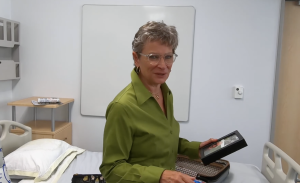
The clothes the actors wear can enhance the authenticity of the virtual simulation. Clothing and the surrounding environment can also be used as a cue to support the learner’s clinical judgement when assessing the overall scene.
If the actor is required to wear prosthetics or medical equipment, it is important to inform the actor during the interview process to determine if they are comfortable and agree with the requirements when filming the scene. For example, the actor may have a fake IV taped on their hand or have nasal prongs in their nostrils. During the rehearsal, provide time for the actor to try the medical equipment, become familiar with the movement/function, explain how it will be used, and to answer any questions they may have regarding the props.
If the actor playing the role of the nurse needs to perform any nursing/healthcare related interventions you will need to teach the actor how to perform the skills correctly. It is good practice to do this a few weeks prior to filming to allow the actors to take the props home to practice on their own time to gain a sense of the feel and how to use the prop (e.g., putting on a blood pressure cuff).
Depending on the simulation scenario, include props that would be normal to see in a real-life situation. If the scenario is based on a pediatric post-operative surgical unit, include monitors, IV equipment, dressings, or catheter into the scene. Or, if the scenario is located in a respite facility, the client may have a suitcase, personal photos, or home linen.
Including props during filming adds realism to help set the scene and provide contextual cues for the learner. The goal of filming is to make the simulation videos look as realistic as possible to an actual clinical setting that is tangible to the learner’s in-person experiences. You want learners to be able to immerse themselves into the simulation story and feel confident to transfer the skills learned during the virtual gaming simulation into their clinical practice environment.
Manikin Models and Body Parts
Depending on the virtual simulation, it may be required to use a manikin because the skills may involve an invasive procedures or exposure of certain body parts. One strategy to keep the actor safe and maintain realism is to use a manikin model/body prosthetic and attach it to the simulated actor. In the postpartum virtual gaming simulation various parts of a manikin model were used instead of the actor. For example, prosthetic breasts during a breastfeeding scene, a prosthetic postpartum abdomen during palpation of the uterus, and prosthetic perineum and anus during the scene when the nurse assessed for hemorrhoids.
When incorporating manikin body parts into a filming scene, it is important to match the actor’s skin tone as much as possible. Manikin models are becoming more diverse in skin tones, shapes, and textures; however, additional make-up may be required to make the body part similar to the actor’s skin appearance. If the manikin’s body part does not match the actor, a technique to avoid direct comparison is to film the scenes separately. The camera can focus on the client’s face when talking, then change focus to the manikin body part only during the skill or assessment. The images below illustrate a manikin abdomen and infant from the Postpartum Nursing Care Virtual Gaming Simulation.
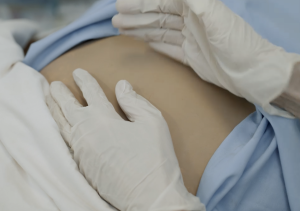
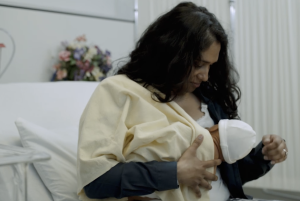
Moulage
Another technique to enhance realism is to incorporate moulage in your virtual simulation. Moulage is a technique that can facilitate fidelity by using makeup and other products to create special effects, such as creating a wound or laceration or changing the physical appearance of a body part. It can be as simple as layering make-up to change a person’s skin tone to more complex by adding texture to create an ulcer or protruding bone.
Educator Tip
With all formats, it is important the actor’s visual appearance is true to the character development. For example, if the actor is playing an older person, you may choose for them to wear a wig. Ensure the wig fits, is realistic and not noticeable with all-natural hair hidden under the wig. Another example could include using moulage. You want to make sure it is as realistic as possible to look like a real ulcer or lesion, ensuring it does not fall off or is the wrong colour.
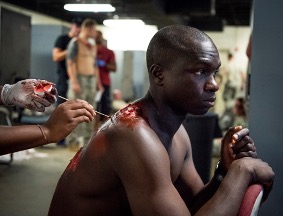
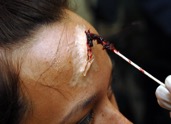
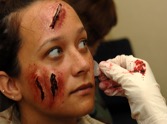
Additional Resources
To learning more about moulage, the following websites have resources to help you to create your own realistic effects for your virtual gaming simulation.
Using moulage makeup for medical training.
Using “Moulage” in Health Care Simulation.
Easy Special Effects Wound tutorial – CRC Makeup.
If you would like to try to create your own moulage and make techniques, Barry Robinson has a helpful website http://www.barrymrobinson.ca/index.html

